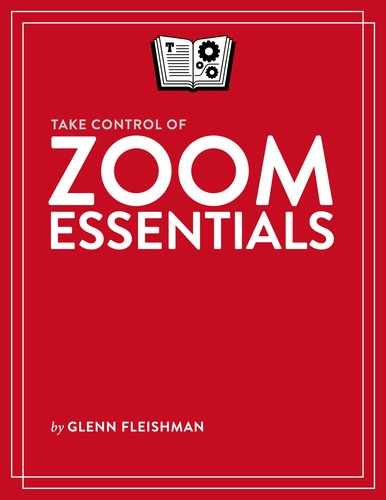Get Set Up with Zoom
Zoom participants never pay Zoom a fee to use the software or be part of a meeting. The person or organization hosting the meeting you join pays any applicable fees (or none if they are using Zoom’s free tier). You don’t even need an account, nor is it mandatory for you to install an app! In-browser web apps with no download requirements exist, as I describe below.
However, I find it easier to use Zoom routinely, configure my setup the way I like it, retain preferences, and use the service with both a registered account and an app. Let’s start with registering an account.
Create an Account
Some meetings may require a Zoom account, which is managed from the Zoom website, so it makes sense to set one up. But it’s also handy to have an account, as it lets you make sure that the settings you want to use with Zoom are already in place whenever you use the service and are logged in.
To sign up for an account:
Visit zoom.us/signup.
Instead of being asked for an email address, you’re first prompted for your birthdate! (Zoom says it uses this only for verification.)
Enter an email address and click Sign Up. You may be prompted to solve a CAPTCHA. (Zoom says to enter a “work” email address, but that’s an outdated message.)
Zoom sends you an email. Click the confirmation link in the email.
This link opens a page that asks, “Are you signing up on behalf of a school?” For most of us, that’s no. Select No and click Continue.
You can now finish account signup by entering your name and password, which you can change later; see Identify Yourself. Click Continue and you’re all set with a free-tier account.
Each account may be used simultaneously with a single desktop or laptop computer, tablet, and smartphone.
Download or Use a Zoom App
You don’t have to install a Zoom app, but the service works best with a “native” app—one that’s written for the operating system on which it runs. Plus, some features are only available in native apps, which are faster, less choppy, and more reliable than the web apps that Zoom offers.
Use a Native Zoom App
Zoom offers native apps for every major platform, including Android, iOS, iPadOS, macOS, and Windows. To get a native app, you can do any of the following:
Visit the Download Center, which automatically figures out what you need. Click or tap the Download button.
Wait until you join your first meeting on a given device. The meeting webpage will prompt you to download the software, but this will delay joining the meeting.
Download directly via these links to Google Play (for Android), the iOS App Store (for iPhone and iPad), or the Mac App Store.
On desktop operating systems, run the installer and follow prompts to install the software. On mobile devices, install the software through the familiar app store process.
Use Zoom in a Browser
You can use Zoom in a desktop browser on nearly all major operating systems without installing additional software. Zoom relies on built-in web standards. (Chrome OS requires an extension.)
Here are the browsers Zoom supports with the minimum version number of the browser you need to have installed, as well as any limitations:
Google Chrome 53: It’s your best choice on every desktop platform, and offers the closest set of features to Zoom’s native desktop apps. (On a Chromebook, install this Chrome extension.)
Microsoft Edge 38: You can’t share your screen using Edge with Windows 10 Home, only with Windows 10 Pro or Enterprise.
Safari 10: Safari users can’t share their screen or audio, requiring a dial-in call to listen or speak.
Firefox 76: Firefox users also can’t share their audio, but can hear streaming sound.
